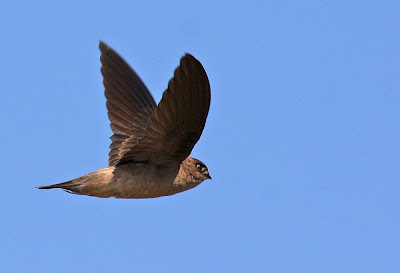
A Little Egret in the early morning light.

And a Wood Sandpiper. I've started to try taking more shots 'against the light' as it produces attractive results if you get it right.

The presence of over 100 Grey-headed Lapwings gave me a good opportunity to improve on previous photographic efforts. This was also the first day I've had chance to try digiscoping in decent light with my new scope. Here's one of the results. A 1st winter (rear) and an adult.

Two adults - the left bird had a considerably browner head and breast and a pale-fringed breastband, while the right hand bird had a much greyer head and breast and a solid black breastband. I wasn't sure whether these two plumage types indicate a difference in gender or just wear and tear, with the browner bird being in fresher plumage. Digiscoped.

Another of the browner type (especially on the crown).

And another of the smart grey ones!






I was pleased to get some decent flight shots in the excellent light.



Wood Sandpipers were everywhere, and this one allowed me to try my hand at digiscoping again. The colours are a bit odd, but overall, I am pleased with the sharpness.



There were lots of Long-toed Stints around too, but these were a bit too fast zipping in and out of the rice clumps to enable me to get any sharp digiscoped shots. All these were taken with the DSLR.


When alarmed, Long-toed Stints adopt a distinctive upright posture with neck outstretched.

Later in the day. What a difference the light makes!



Later in the morning a raptor appeared, but it wasn't the eagle! At first I thought this was a juvenile/1st winter 'govinda' Black Kite, due to the indistinct pale under-primary patch. However, I now think it is more likely a dark adult 'lineatus'. I am basing my tentative identification on the very pale yellow legs and whitish-yellow cere, the whitish forehead and rather rufous underparts. Wells mentions that 'lineatus' has bluish-white cere and legs at all ages but some photos of 'lineatus' on OBI cast doubt on this in my mind. Any help on this would be greatly appreciated, especially as the two races are now widely treated as distinct at species level.

The light was good today for photographing swiftlets, and I was able to answer some of my own queries arising from the last few posts. I assumed that these birds were German's Swiftlets, owing to the close proximity of a 'swiftlet hotel' and the fact that in this area I have only seen 'white nests' in such places. Earlier I noted that Himalayan Swiftlets have a blue-black gloss on the upperwing, and it is clear from these pics (if they are indeed German's) that this feature is not unique to Himalayan. It appears to be a feature of freshly moulted feathers of German's too.

From the pale tips to the greater coverts I would guess that this is a juvenile moulting into its first set of adult feathers.

The tail fork on this bird seems to me to be as deep as the Himlayan Swiftlets I photographed in northern Thailand, so that may not be a useful feature to separate Himalayan from other Aerodramus in the field.

This bird appears to have pale shaft streaks on the flanks...

..whereas this one (a juvenile?) appears to have quite uniform underparts. So could dark shaft streaks on the flanks and belly be a useful diagnostic feature of Himalayan??

Something easier to relieve the brain-ache! A stunning fresh-plumaged Blue-tailed Bee-eater.

There were a few Intermediate Egrets among the more numerous Little, Great and Cattle Egrets. They have distinctively small round heads and short bills.

My last model of the day - a Barn Swallow. The small lump on the right of the picture is a pellet containing all the indigestible parts of the insects it catches.

It posed for a portrait!
6 comments:
Dave, those grey headed Lapwings are certainly good looking. I saw them as lifers in Juru. the yseems to be more common in the north than in the south section of PM.
I think there is strong probability of the BK being a "lineatus". Those large pale underwing patches, and pale cere tend to point to lineatus rather than govindas which tyoically sport brighter yellow ceres.
ATiah
Thanks Aun Tiah. I appreciate your wisdom on the kite.
Dave
Excellent shot of the wood sandpiper Dave :)
Dear Dave,
the Black Kite were lineatus race. Good pic of the bird. I enjoy all your write up in your blog
terence
great shots!
Very nice identification for the swift!
Beautiful shots for Grey-headed Lapwing also.
They're summer breeder here in Japan.
Post a Comment